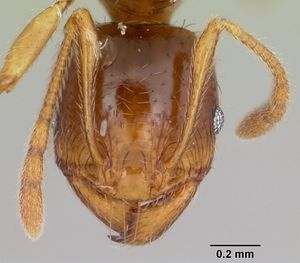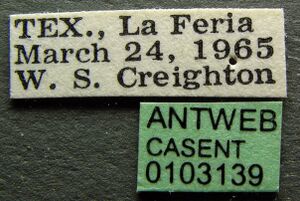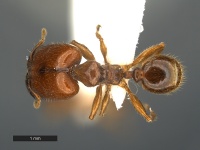Pheidole absurda
| Pheidole absurda | |
|---|---|

| |
| Scientific classification | |
| Kingdom: | Animalia |
| Phylum: | Arthropoda |
| Class: | Insecta |
| Order: | Hymenoptera |
| Family: | Formicidae |
| Subfamily: | Myrmicinae |
| Tribe: | Attini |
| Genus: | Pheidole |
| Species: | P. absurda |
| Binomial name | |
| Pheidole absurda Forel, 1886 | |
| Synonyms | |
| |
Pheidole absurda excavates deep nests in soil. Colonies are granivorous and store seeds in special chambers. Creighton (1966) studied the habits of this species (as P. ridicula) in south Texas. (Longino 2003)
Identification
See the description in the nomenclature section and, from The Ants of Costa Rica: Minor worker: head length 0.74mm, head width 0.68mm, scape length 0.65mm, Webers length 0.91mm (n=1). Head flattened behind; promesonotum evenly arched, mesonotal suture absent; propodeal spines short, sharp, upturned; face shining, largely smooth, with longitudinal carinae between eyes and frontal carinae, faint transverse carinae near posterior border; mesosoma largely smooth and shining, with transverse rugae on anterodorsal pronotum and propodeal dorsum; gaster smooth and shining; dorsal pilosity abundant, of moderate length, flexuous; color light yellow brown.
Major worker: head length 2.38mm, head width 1.79mm, scape length 0.76mm (n=1). Face largely smooth and shining; hypostomal margin with no medial tooth, pair of subtriangular teeth located closer to midline than to recessed teeth flanking mandibles; dorsal pilosity abundant on mesosoma and gaster; pilosity on head sparse, with only a few setae projecting from sides of head in face view.
Keys including this Species
Distribution
The Brownsville area of extreme southern Texas south to Costa Rica. I have seen material from the Yucatan Peninsula and Guatemala. Kempf (1972b) reports absurda from the "Guianas," but this needs verification. (Wilson 2003)
Latitudinal Distribution Pattern
Latitudinal Range: 33.96159° to 8.85301°.
| North Temperate |
North Subtropical |
Tropical | South Subtropical |
South Temperate |
- Source: AntMaps
Distribution based on Regional Taxon Lists
Nearctic Region: United States.
Neotropical Region: Costa Rica, Guatemala (type locality), Honduras, Mexico, Nicaragua.
Distribution based on AntMaps
Distribution based on AntWeb specimens
Check data from AntWeb
Countries Occupied
| Number of countries occupied by this species based on AntWiki Regional Taxon Lists. In general, fewer countries occupied indicates a narrower range, while more countries indicates a more widespread species. |

|
Estimated Abundance
| Relative abundance based on number of AntMaps records per species (this species within the purple bar). Fewer records (to the left) indicates a less abundant/encountered species while more records (to the right) indicates more abundant/encountered species. |

|
Biology
Near Campeche I found a nest in moist clay of a thorn forest. Soil nests are also reported by Longino (1997) in Costa Rica and by Creighton (1966) in Texas. According to Creighton, the nest entrance is an inconspicuous hole 2- 5 mm in diameter, leading to a diffuse system of galleries and chambers that descend as much as a meter into the ground. A mature colony contains at least 75 majors and 300 minors. The colonies harvest seeds (Amaranthus palmeri at Creighton's study site) and store them in granary chambers. The minors strip the ovary shards away from the seeds, and the majors crack them open. The majors also serve as very effective guards, using their mandibles like wire clippers to chop off appendages of arthropod intruders. In observation nests they proved more than a match for other Pheidole and the native fire ant Solenopsis geminata. (Wilson 2003)
Creighton (1966) - The foraging responses of ridicula (=absurda) are flexible and this makes them difficult to describe. Much of the foraging occurs at night but it is misleading to characterize ridicula as a nocturnal forager. If the nest area is shaded, or if the day is overcast, foraging may occur over a twenty-four hour period. Even when the nest is not shaded foraging ordinarily continues
until mid-morning. Foraging may be diffuse or the foragers may form columns. Most of the seeds brought in are picked up from surface litter and in this type of foraging columns rarely form. But when a concentrated food source is at hand, the foragers will converge on it and a column may result. The foragers seldom get far from the nest. In each of the seven colonies most of the foraging was done within ten feet of the nest entrance. The majors take no part in the foraging although they will leave the nest with the minors. When they do so they restrict their patrol to the area around the nest entrance and it is exceptional to find them more than a foot from it. During vigorous foraging there may be several majors outside the nest and their activities effectively clear the area of other ants.
In the encounters which occurred daily around each of the nests, the majors of ridicula rarely got the worst of it. They disposed of the majors of Pheidole floridana, Pheidole metallescens and Pheidole dentata with ease and had little trouble with those of Solenopsis geminata. They would occasionally kill workers of Pogonomyrmex barbatus although this species was more often driven away than killed. There can, however, be no doubt about the high efficiency of the major of ridicula as a guard.
In addition to its activities as a guard the major of ridicula also functions as a seed crusher. When the major opens one of these seeds (Amaranthus palmeri) it picks it up by closing the mandibles on the lateral surfaces of the seed. Increasing pressure on these surfaces ultimately shatters the seed. In the observation nests the majors opened a number of seeds in quick succession.
Regional Information
Costa Rica
Monteverde (San Luis Valley): edge of forest patch in upper San Luis valley; nest in soil well beneath soil surface; nest exposed during excavation (collected by Jeremy Miller). (reported by Longino)
Association with Other Organisms
 Explore: Show all Associate data or Search these data. See also a list of all data tables or learn how data is managed.
Explore: Show all Associate data or Search these data. See also a list of all data tables or learn how data is managed.
Nematode
- This species is a host for the nematode Mermithidae (unspecified "Mermix") (a parasite) in Neotropics (Wheeler, 1928; Laciny, 2021).
Castes
Minor
Images from AntWeb
  
| |
| Worker. Specimen code casent0103138. Photographer April Nobile, uploaded by California Academy of Sciences. | Owned by USNM, Washington, DC, USA. |
Major
Images from AntWeb
   
| |
| Worker (major/soldier). Specimen code casent0103139. Photographer April Nobile, uploaded by California Academy of Sciences. | Owned by USNM, Washington, DC, USA. |
Nomenclature
The following information is derived from Barry Bolton's Online Catalogue of the Ants of the World.
- absurda. Pheidole absurda Forel, 1886b: xlvii (s.) GUATEMALA. Emery, 1890b: 48 (w.). Senior synonym of ridicula: Wilson, 2003: 646. See also: Emery, 1894k: 54.
- ridicula. Pheidole ridicula Wheeler, W.M. 1916f: 29, fig. 1 (s.) U.S.A. Junior synonym of absurda: Wilson, 2003: 646. See also: Creighton, 1966b: 1.
Unless otherwise noted the text for the remainder of this section is reported from the publication that includes the original description.
Description
From Wilson (2003): DIAGNOSIS A large member of the tristis group distinguished by the disproportionately large, elongate head of the major. The major is also characterized by a nearly complete lack of sculpturing on the head and body other than carinulae found on the dorsal surface of the head from the level of the eyes forward; very low meso somal convexity; propodeal spines small and erect. Minor: occiput broad, lacking nuchal collar; body almost completely smooth, lacking any sculpturing except for carinulae on the dorsal head surface at the level of the eye and anterior to it.
MEASUREMENTS (mm) Lectotype major: HW 1.80, HL 2.38, SL 0.82, EL 0.24, PW 0.84. Paralectotype minor: HW 0.64, HL 0.68, SL 0.64, EL 0.14, PW 0.42.
COLOR Major: head reddish yellow, mandibles medium reddish brown, rest of body and appendages yellowish brown.
Minor: body light brown, appendages brownish yellow.
Figure. Upper: major. The body is drawn from a specimen from 10 km east of Campeche, Mexico, col. E. O. Wilson, compared with the lectotype major in Musee d'Histoire Naturelle Genève; the head is drawn from the lectotype major. Lower: paralectotype, minor. Scale bars = 1 mm.
Type Material
GUATEMALA: Retalhuleu. Musee d'Histoire Naturelle Genève - as reported in Wilson (2003)
Etymology
L absurda, foolish, silly, referring to the very large, elongate head of the major. (Wilson 2003)
References
- Creighton, W. S. 1966. The habits of Pheidole ridicula Wheeler with remarks on habit patterns in the genus Pheidole (Hymenoptera: Formicidae). Psyche (Cambridge) 73:1-7. [1966-08-31]
- Emery, C. 1890c. Studii sulle formiche della fauna neotropica. Bull. Soc. Entomol. Ital. 22: 38-80 (page 48, worker described)
- Emery, C. 1894l. Estudios sobre las hormigas de Costa Rica. An. Mus. Nac. Costa Rica 1888- 1889: 45-64 (page 54, see also)
- Forel, A. 1886b. Espèces nouvelles de fourmis américaines. Ann. Soc. Entomol. Belg. 30:xxxviii-xlix. (page xlvii, soldier described)
- Kempf, W. W. 1972b. Catálogo abreviado das formigas da região Neotropical. Stud. Entomol. 15: 3–344.
- Wheeler, W.M. 1928. Mermis parasitism and intercastes among ants. Journal of Experimental Zoology 50: 165-237 (doi:10.1002/jez.1400500202).
- Wilson, E. O. 2003. Pheidole in the New World: A dominant, hyperdiverse ant genus. Harvard University Press, Cambridge, MA. (page 646, fig. major, minor described; page 646, Senior synonym of ridicula)
References based on Global Ant Biodiversity Informatics
- Ahuatzin D. A., E. J. Corro, A. Aguirre Jaimes, J. E. Valenzuela Gonzalez, R. Machado Feitosa, M. Cezar Ribeiro, J. Carlos Lopez Acosta, R. Coates, W. Dattilo. 2019. Forest cover drives leaf litter ant diversity in primary rainforest remnants within human-modified tropical landscapes. Biodiversity and Conservation 28(5): 1091-1107.
- Dattilo W. et al. 2019. MEXICO ANTS: incidence and abundance along the Nearctic-Neotropical interface. Ecology https://doi.org/10.1002/ecy.2944
- Fernandes, P.R. XXXX. Los hormigas del suelo en Mexico: Diversidad, distribucion e importancia (Hymenoptera: Formicidae).
- Fernández, F. and S. Sendoya. 2004. Lista de las hormigas neotropicales. Biota Colombiana Volume 5, Number 1.
- Kempf, W.W. 1972. Catalago abreviado das formigas da regiao Neotropical (Hym. Formicidae) Studia Entomologica 15(1-4).
- Longino J. et al. ADMAC project. Accessed on March 24th 2017 at https://sites.google.com/site/admacsite/
- Moody J. V., and O. F. Francke. 1982. The Ants (Hymenoptera, Formicidae) of Western Texas Part 1: Subfamily Myrmicinae. Graduate Studies Texas Tech University 27: 80 pp.
- O'Keefe S. T., J. L. Cook, T. Dudek, D. F. Wunneburger, M. D. Guzman, R. N. Coulson, and S. B. Vinson. 2000. The Distribution of Texas Ants. The Southwestern Entomologist 22: 1-92.
- Vásquez-Bolaños M. 2011. Lista de especies de hormigas (Hymenoptera: Formicidae) para México. Dugesiana 18: 95-133
- Wheeler, G.C. and J. Wheeler. 1985. A checklist of Texas ants. Prairie Naturalist 17:49-64.
- Wilson, E.O. 2003. Pheidole in the New World: A Dominant, Hyperdiverse Genus. Harvard University Press



